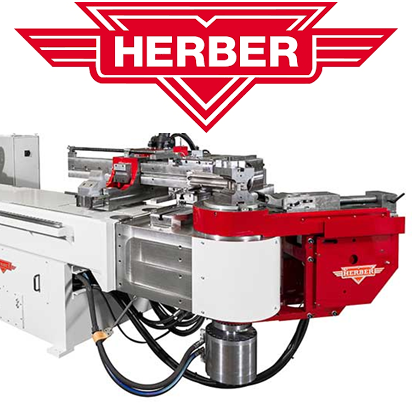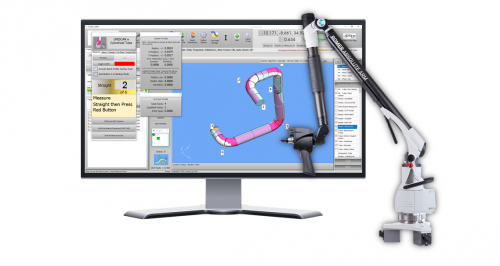Difference between revisions of "VTube HERBER Bender Correction (MES Protocol)"
(→STEP 6 - OPTIONAL STEP - You Can Manually Change the ADJUSTMENT Values) |
(→STEP 2: Setup the Benderlink Network Grid for HERBER MES Protocol) |
||
| (15 intermediate revisions by one user not shown) | |||
| Line 79: | Line 79: | ||
#Choose an unused row in the grid for a new HERBER bender setup.<br><br> | #Choose an unused row in the grid for a new HERBER bender setup.<br><br> | ||
#Assign a bender name that will help operators identify which bender this is. This text will be displayed at the top of the Bender Setup menu.<br><br> | #Assign a bender name that will help operators identify which bender this is. This text will be displayed at the top of the Bender Setup menu.<br><br> | ||
| − | #Assign the HERBER MES protocol.<br><br> | + | #Assign the HERBER MES+SOL protocol.<br><br> |
#Enter the path to the shared drive or folder in the NetPath field. This path should point to the HERBER folder that will receive MES files from VTube. (The value shown on the screen is only an example.)<br><br> | #Enter the path to the shared drive or folder in the NetPath field. This path should point to the HERBER folder that will receive MES files from VTube. (The value shown on the screen is only an example.)<br><br> | ||
#Enter the IP address in the PING IP ADDRESS field if it is a fixed field. (This is not required. It allows VTube to ping the address to see if the network location is active before trying to open communications.)<br><br> | #Enter the IP address in the PING IP ADDRESS field if it is a fixed field. (This is not required. It allows VTube to ping the address to see if the network location is active before trying to open communications.)<br><br> | ||
| Line 166: | Line 166: | ||
</table> | </table> | ||
| − | ===STEP | + | |
| + | ===STEP 6 - OPTIONAL STEP - You Can Manually Change the ADJUSTMENT Values=== | ||
<table cellpadding=10> | <table cellpadding=10> | ||
<tr valign=top> | <tr valign=top> | ||
<td width=300> | <td width=300> | ||
| − | + | You can manually change the ADJUSTMENT values before sending corrections if you want to. Some users like to set the first and last Length adjustment to zero in order to keep the start position of the carriage in the same place - for when they have extra length on the ends.<br><br> | |
| + | If you want to, it is even possible to invert the rotation direction to keep the tube from hitting the bender during rotations. | ||
<td> | <td> | ||
| − | [[image:vtl_v2.9. | + | [[image:vtl_v2.9.10 HERBER Manually Adjust Correction Values.png|400px]]<br><br> |
</td> | </td> | ||
</tr> | </tr> | ||
</table> | </table> | ||
| − | ===STEP 7 - Send | + | ===STEP 7 - Send Corrections to the HERBER=== |
<table cellpadding=10> | <table cellpadding=10> | ||
<tr valign=top> | <tr valign=top> | ||
<td width=300> | <td width=300> | ||
| − | + | Press "Auto SEND Bender CORRECTIONS". VTube-LASER will let you select a path, then save a MES file to that path. | |
| − | + | ||
<td> | <td> | ||
| − | [[image: | + | [[image:vtl_v2.9.10_herber_send_corrections.png|400px]]<br><br> |
</td> | </td> | ||
</tr> | </tr> | ||
| Line 196: | Line 197: | ||
You can allow this window to close on its own in a few seconds, or press the close button to close it immediately. | You can allow this window to close on its own in a few seconds, or press the close button to close it immediately. | ||
<td> | <td> | ||
| − | [[image: | + | [[image:vtl_v2.9.10 HERBER Send Adjusted Complete.png|400px]]<br><br> |
</td> | </td> | ||
</tr> | </tr> | ||
</table> | </table> | ||
| − | ===STEP 9 - IMPORT the Correction Data at the | + | ===STEP 9 - IMPORT the Correction Data at the HERBER Control=== |
| Line 207: | Line 208: | ||
<tr valign=top> | <tr valign=top> | ||
<td width=500> | <td width=500> | ||
| − | Move to the | + | Move to the HERBER control and follow these steps:<br><br> |
| − | + | * Click on “Read measurement from machine” in the Communications menu.<br><br> | |
| − | + | * Select your measuring system (VTube). | |
| − | + | ||
| − | + | ||
</td> | </td> | ||
<td> | <td> | ||
| − | [[image: | + | [[image:HERBERScreen1.png|500px]]<br> |
</td> | </td> | ||
</tr> | </tr> | ||
| + | |||
| + | <tr valign=top> | ||
| + | <td width=500> | ||
| + | * Select the .MES file VTube-LASER just created. When you click OK, the HERBER software will ask if you want to delete the MES file after importing.<br><br> | ||
| + | * To apply all corrections from the mes file, click on “Save all measurements” and continue bending. You are not required to stop the machine to do this. The HERBER cell allows for correction in an automated production cell in realtime. The corrections will be applied for the next part bent. | ||
| + | |||
| + | </td> | ||
| + | <td> | ||
| + | [[image:HERBERScreen2.png|500px]]<br> | ||
| + | |||
| + | </td> | ||
| + | </tr> | ||
| + | |||
| + | <tr valign=top> | ||
| + | <td width=500> | ||
| + | * It is also possible to delete or save individual correction values by marking a bend and opening the measure tab. | ||
| + | |||
| + | </td> | ||
| + | <td> | ||
| + | [[image:HERBERScreen3.png|500px]]<br> | ||
| + | |||
| + | </td> | ||
| + | </tr> | ||
| + | |||
</table> | </table> | ||
| Line 225: | Line 248: | ||
Bend the corrected tube starting in Step 1, then measure it again (Step 2) and follow the rest of the steps until the part is within tolerance. | Bend the corrected tube starting in Step 1, then measure it again (Step 2) and follow the rest of the steps until the part is within tolerance. | ||
<td> | <td> | ||
| − | [[image: | + | [[image:HERBER Control Station.png|200px]] [[image:herber bender large tube bending.png|400px]] |
</td> | </td> | ||
</tr> | </tr> | ||
Latest revision as of 20:38, 5 July 2018
|
This page describes the use of the VTube-LASER to HERBER bender corrections using the HERBER MES protocol. |
Back to VTube-LASER
Network Protocol
|
The protocol used is called "HERBER MES" and runs through a standard network connection - wired or wireless. |
HERBER MES Data Protocol Information
These are important facts to know about this protocol.
|
BENDERLINK SETUP STEPS FOR VTUBE-LASER
STEP 1: Enter the SYSTEM OPTIONS Menu in VTube
|
STEP 2: Setup the Benderlink Network Grid for HERBER MES Protocol
|
 How to SEND CORRECTION Data to the HERBER Control from VTube-LASER
How to SEND CORRECTION Data to the HERBER Control from VTube-LASER
STEP 1 - Bend the Tube
|
Bend the tube in the HERBER bender. |
STEP 2 - Measure the tube with VTube-LASER
|
Measure and align the tube to determine if it qualifies by falling within the envelope tolerance for the tube shape. |
STEP 3 - Enter BENDER SETUP
|
Click on the BENDER SETUP button in the Navigation Pane. |
STEP 4 - Choose the BENDER NUMBER
|
Set the correct bender number at the top of the window. |
STEP 5 - COPY the Data from VTube-LASER's Main Memory
|
If this is the first correction, then the Bender Setup screen may show no data. If this is the case, then it is necessary to update the Bender Setup screen from VTube-LASER's main memory like this:
|
STEP 6 - OPTIONAL STEP - You Can Manually Change the ADJUSTMENT Values
|
You can manually change the ADJUSTMENT values before sending corrections if you want to. Some users like to set the first and last Length adjustment to zero in order to keep the start position of the carriage in the same place - for when they have extra length on the ends. |
STEP 7 - Send Corrections to the HERBER
|
Press "Auto SEND Bender CORRECTIONS". VTube-LASER will let you select a path, then save a MES file to that path. |
STEP 8 - The SEND to BENDER Complete Window
|
A window should appear for a few seconds indicating that the Send to the Bender is complete. |
STEP 9 - IMPORT the Correction Data at the HERBER Control
|
Move to the HERBER control and follow these steps:
|
|
|
|
|
STEP 10 - REPEAT STEPS 1 THROUGH 9
|
Bend the corrected tube starting in Step 1, then measure it again (Step 2) and follow the rest of the steps until the part is within tolerance. |
Other Pages
- See VTube-LASER
- See VTube-STEP
- See UNISON for information on UNISON benders

















